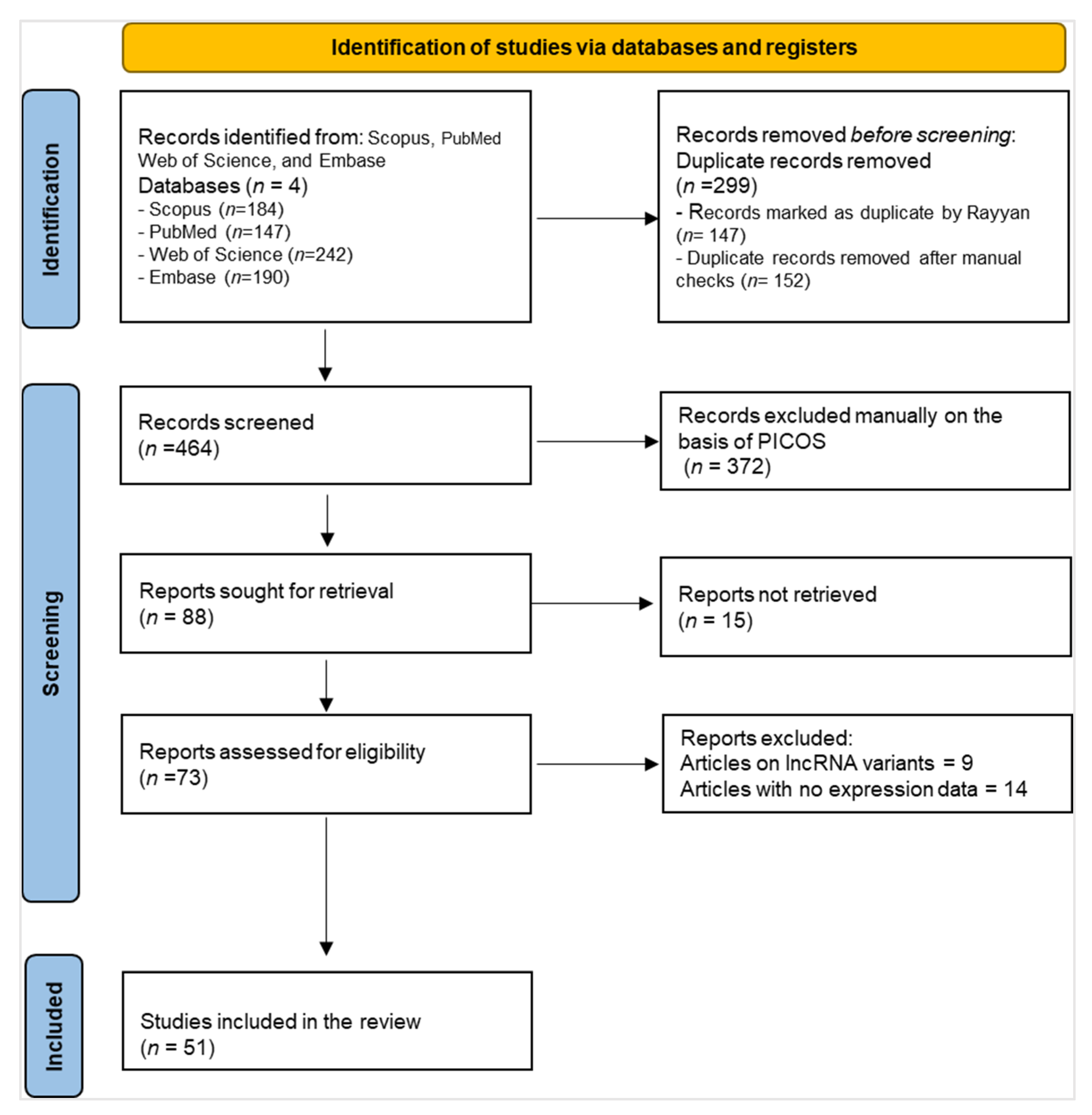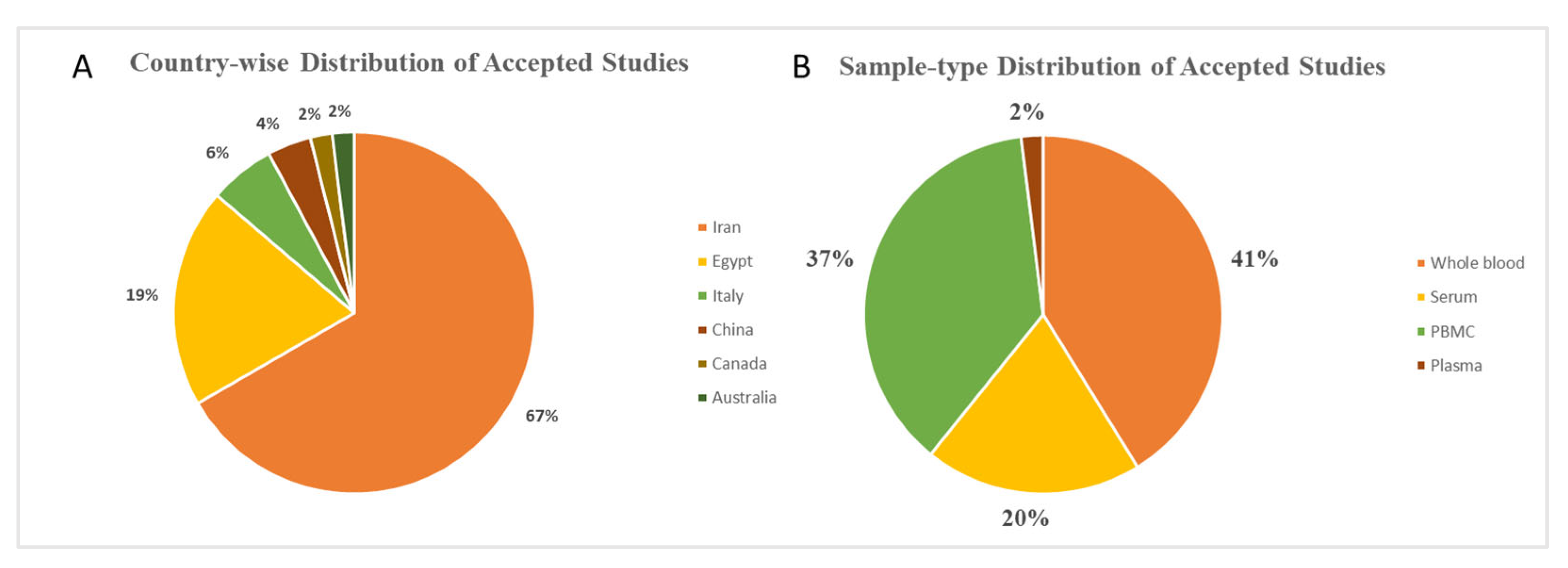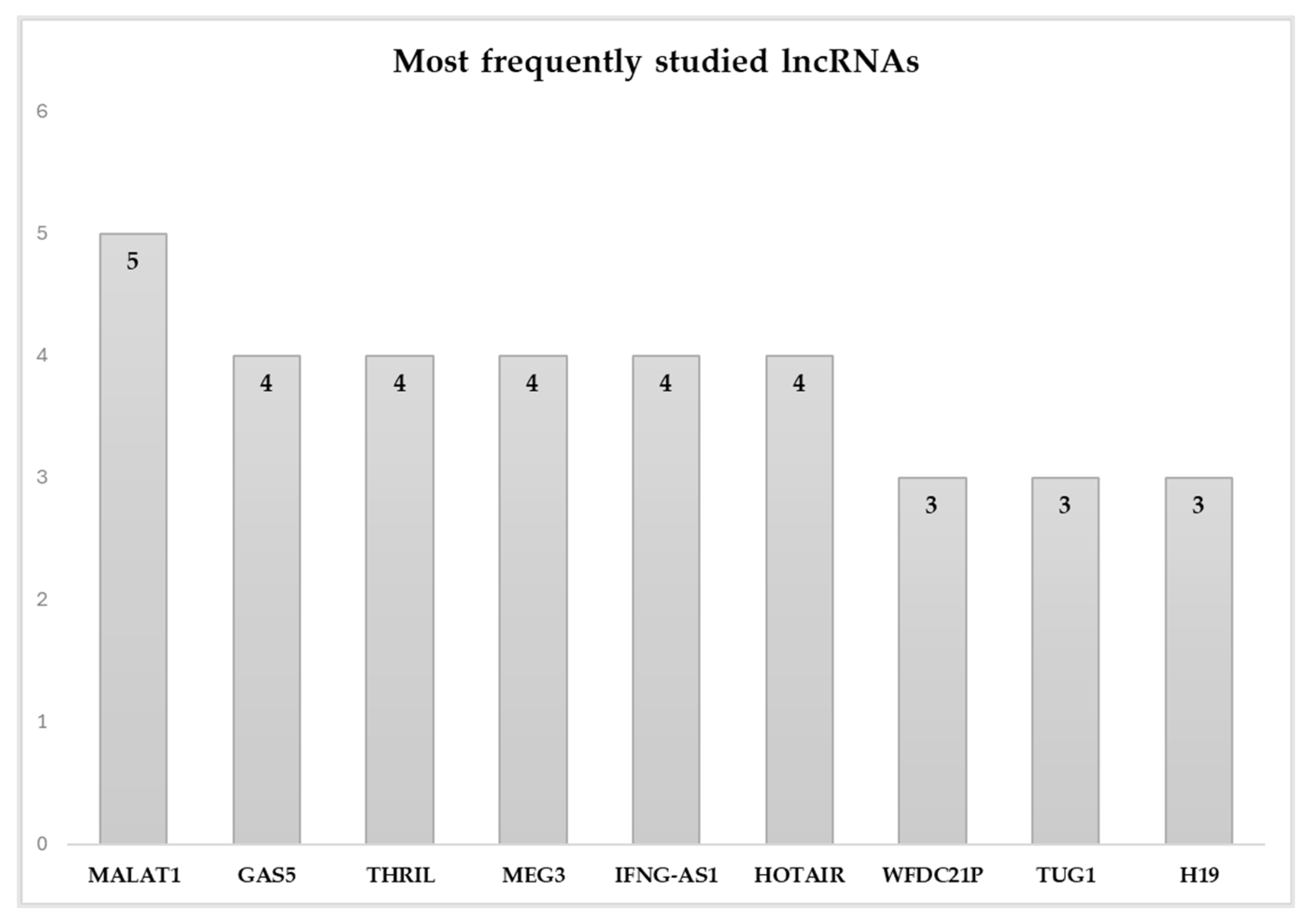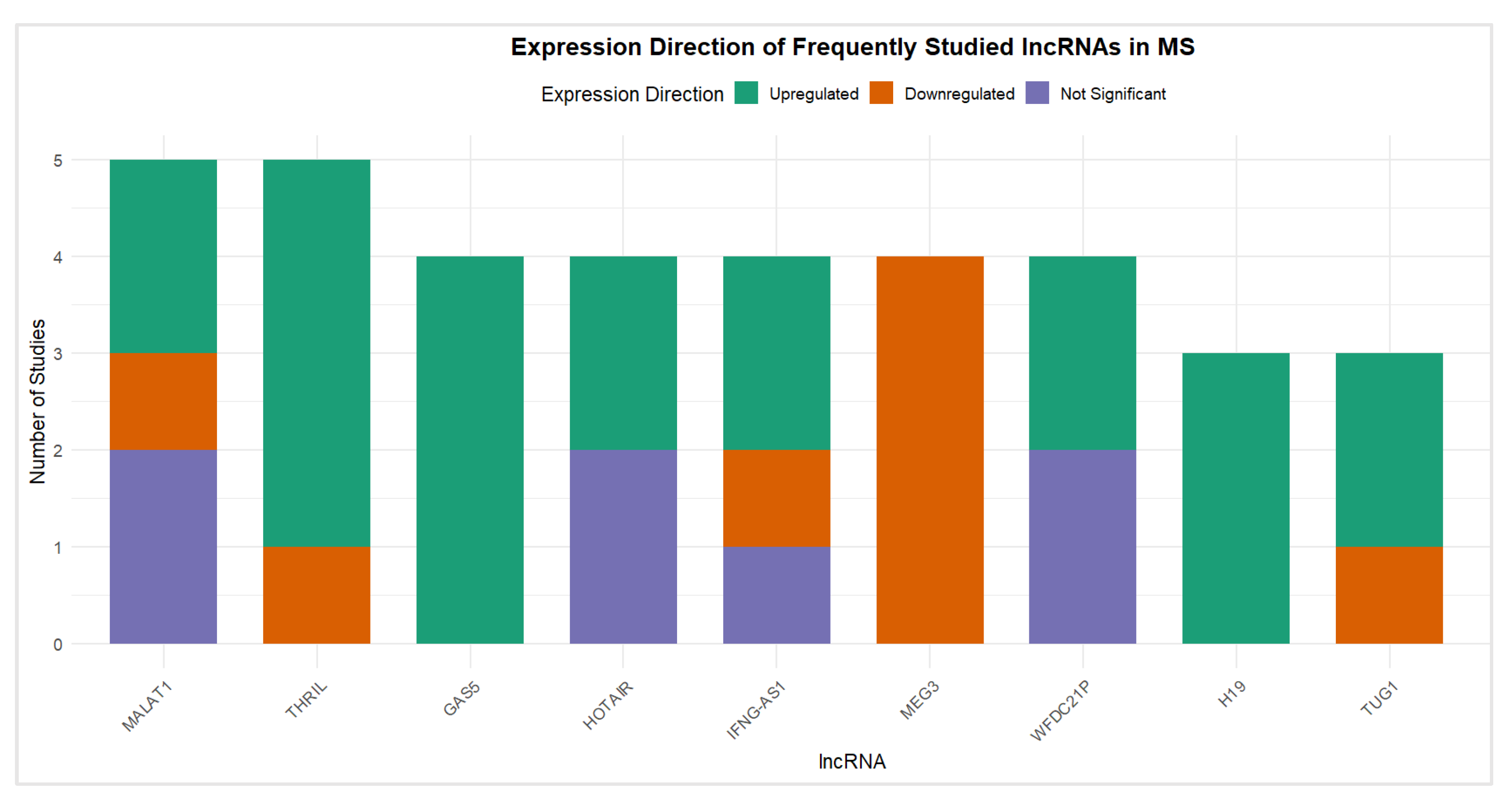Long Non-Coding RNAs in Multiple Sclerosis—Differential Expression and Functional Implications
Abstract
1. Introduction
2. Materials and Methods
2.1. Search Strategy and Inclusion/Exclusion Criteria
2.2. Study Selection, Data Extraction and Analysis
2.3. Risk of Bias Assessment
3. Results
3.1. Study Selection and Characteristics
3.2. lncRNA Frequency and Trends
3.3. Risk of Bias
3.4. Observed Differential Expression of Most Studied lncRNAs
4. Discussion
4.1. Summary of Key Findings
4.2. Functional Implication of the Frequently Studied lncRNAs
4.3. Biases and Limitations in the Literature
4.4. Implications for Future Research
4.5. Strengths and Limitations of This Review
5. Conclusions
Supplementary Materials
Author Contributions
Funding
Institutional Review Board Statement
Informed Consent Statement
Data Availability Statement
Conflicts of Interest
Abbreviations
References
- Filippi, M.; Bar-Or, A.; Piehl, F.; Preziosa, P.; Solari, A.; Vukusic, S.; Rocca, M.A. Multiple Sclerosis. Nat. Rev. Dis. Prim. 2018, 4, 43. [Google Scholar] [CrossRef]
- Michaličková, D.; Hrnčíř, T.; Canová, N.K.; Slanař, O. Targeting Keap1/Nrf2/ARE Signaling Pathway in Multiple Sclerosis. Eur. J. Pharmacol. 2020, 873, 172973. [Google Scholar] [CrossRef] [PubMed]
- Cipriano, G.L.; Schepici, G.; Mazzon, E.; Anchesi, I. Multiple Sclerosis: Roles of MiRNA, LcnRNA, and CircRNA and Their Implications in Cellular Pathways. Int. J. Mol. Sci. 2024, 25, 2255. [Google Scholar] [CrossRef] [PubMed]
- Dadyar, M.; Hussen, B.M.; Eslami, S.; Taheri, M.; Emadi, F.; Ghafouri-Fard, S.; Sayad, A. Expression of T Cell-Related LncRNAs in Multiple Sclerosis. Front. Genet. 2022, 13, 967157. [Google Scholar] [CrossRef]
- Janamiri, S.; Hussen, B.M.; Heidari, S.; Taheri, M.; Eslami, S.; Dadmehr, M.; Ghafouri-Fard, S.; Farahmand, S. Abnormal Level of VDR-Associated LncRNAs in Patients with Multiple Sclerosis. Biomark. Neuropsychiatry 2023, 9, 100082. [Google Scholar] [CrossRef]
- Azari, H.; Karimi, E.; Shekari, M.; Tahmasebi, A.; Nikpoor, A.R.; Negahi, A.A.; Sanadgol, N.; Mousavi, P. Construction of a LncRNA-MiRNA-MRNA Network to Determine the Key Regulators of the Th1/Th2 Imbalance in Multiple Sclerosis. Epigenomics 2021, 13, 1797–1815. [Google Scholar] [CrossRef]
- Amiri, M.; Mokhtari, M.J.; Bayat, M.; Safari, A.; Dianatpuor, M.; Tabrizi, R.; Borhani-Haghighi, A. Expression and Diagnostic Values of MIAT, H19, and NRON Long Non-Coding RNAs in Multiple Sclerosis Patients. Egypt. J. Med. Hum. Genet. 2022, 23, 46. [Google Scholar] [CrossRef]
- Senousy, M.A.; Shaker, O.G.; Sayed, N.H.; Fathy, N.; Kortam, M.A. LncRNA GAS5 and MiR-137 Polymorphisms and Expression Are Associated with Multiple Sclerosis Risk: Mechanistic Insights and Potential Clinical Impact. ACS Chem. Neurosci. 2020, 11, 1651–1660. [Google Scholar] [CrossRef]
- Page, M.J.; McKenzie, J.E.; Bossuyt, P.M.; Boutron, I.; Hoffmann, T.C.; Mulrow, C.D.; Shamseer, L.; Tetzlaff, J.M.; Akl, E.A.; Brennan, S.E.; et al. The PRISMA 2020 Statement: An Updated Guideline for Reporting Systematic Reviews. BMJ 2021, 372, 71. [Google Scholar] [CrossRef]
- PROSPERO. Available online: https://www.crd.york.ac.uk/PROSPERO/home (accessed on 16 September 2025).
- Ouzzani, M.; Hammady, H.; Fedorowicz, Z.; Elmagarmid, A. Rayyan—A Web and Mobile App for Systematic Reviews. Syst. Rev. 2016, 5, 210. [Google Scholar] [CrossRef]
- Higgins, J.P.T.; Thomas, J.; Chandler, J.; Cumpston, M.; Li, T.; Page, M.J.; Welch, V.A. Cochrane Handbook for Systematic Reviews of Interventions; John Wiley & Sons: Chichester, UK, 2019. [Google Scholar]
- Whiting, P.F.; Rutjes, A.W.S.; Westwood, M.E.; Mallett, S.; Deeks, J.J.; Reitsma, J.B.; Leeflang, M.M.G.; Sterne, J.A.C.; Bossuyt, P.M.M. QUADAS-2: A Revised Tool for the Quality Assessment of Diagnostic Accuracy Studies. Ann. Intern. Med. 2011, 155, 529–536. [Google Scholar] [CrossRef]
- Seal, R.L.; Braschi, B.; Gray, K.; Jones, T.E.M.; Tweedie, S.; Haim-Vilmovsky, L.; Bruford, E.A. Genenames.Org: The HGNC Resources in 2023. Nucleic Acids Res. 2023, 51, D1003–D1009. [Google Scholar] [CrossRef] [PubMed]
- Gharesouran, J.; Taheri, M.; Sayad, A.; Ghafouri-Fard, S.; Mazdeh, M.; Omrani, M.D. A Novel Regulatory Function of Long Non-Coding RNAs at Different Levels of Gene Expression in Multiple Sclerosis. J. Mol. Neurosci. 2019, 67, 434–440. [Google Scholar] [CrossRef] [PubMed]
- Rahimi Naiini, M.; Saeidi, K.; Azarian, A.; Bahramzadeh, K.; Nazari-Robati, M. Expression Analysis of Vitamin D Receptor-Associated Long Noncoding RNAs in Patients with Relapsing-Remitting Multiple Sclerosis. Bratisl. Med. J. 2024, 125, 107–112. [Google Scholar] [CrossRef] [PubMed]
- Fenoglio, C.; Oldoni, E.; Serpente, M.; De Riz, M.A.; Arcaro, M.; D’Anca, M.; Pietroboni, A.M.; Calvi, A.; Lecchi, E.; Goris, A.; et al. LncRNAs Expression Profile in Peripheral Blood Mononuclear Cells from Multiple Sclerosis Patients. J. Neuroimmunol. 2018, 324, 129–135. [Google Scholar] [CrossRef] [PubMed]
- Shaker, O.G.; Mahmoud, R.H.; Abdelaleem, O.O.; Ibrahem, E.G.; Mohamed, A.A.; Zaki, O.M.; Abdelghaffar, N.K.; Ahmed, T.I.; Hemeda, N.F.; Ahmed, N.A.; et al. LncRNAs, MALAT1 and Lnc-DC as Potential Biomarkers for Multiple Sclerosis Diagnosis. Biosci. Rep. 2019, 39, BSR20181335. [Google Scholar] [CrossRef]
- Cardamone, G.; Paraboschi, E.M.; Soldà, G.; Cantoni, C.; Supino, D.; Piccio, L.; Duga, S.; Asselta, R. Not Only Cancer: The Long Non-Coding RNA MALAT1 Affects the Repertoire of Alternatively Spliced Transcripts and Circular RNAs in Multiple Sclerosis. Hum. Mol. Genet. 2019, 28, 1414–1428. [Google Scholar] [CrossRef]
- Mayama, T.; Marr, A.K.; Kino, T. Differential Expression of Glucocorticoid Receptor Noncoding RNA Repressor Gas5 in Autoimmune and Inflammatory Diseases. Horm. Metab. Res. 2016, 48, 550–557. [Google Scholar] [CrossRef]
- Kamel, M.M.; Shaker, O.G.; Hassan, A.; Waly, N.E. HOTAIR (Homeobox Antisense Intergenic RNA) and GAS-5 (Growth Arrest—Specific 5) Expressions as Biomarkers for Early Diagnosis of Multiple Sclerosis (MS). Eur. J. Mol. Clin. Med. 2020, 7, 561–576. [Google Scholar]
- Gharesouran, J.; Taheri, M.; Sayad, A.; Ghafouri-Fard, S.; Mazdeh, M.; Omrani, M.D. The Growth Arrest-Specific Transcript 5 (GAS5) and Nuclear Receptor Subfamily 3 Group C Member 1 (NR3C1): Novel Markers Involved in Multiple Sclerosis. Int. J. Mol. Cell. Med. 2018, 7, 102–110. [Google Scholar] [CrossRef]
- Eftekharian, M.M.; Ghafouri-Fard, S.; Soudyab, M.; Omrani, M.D.; Rahimi, M.; Sayad, A.; Komaki, A.; Mazdeh, M.; Taheri, M. Expression Analysis of Long Non-Coding RNAs in the Blood of Multiple Sclerosis Patients. J. Mol. Neurosci. 2017, 63, 333–341. [Google Scholar] [CrossRef]
- Soltanmoradi, S.; Tavakolpour, V.; Moghadasi, A.N.; Kouhkan, F. Expression Analysis of NF-ΚB-Associated Long Noncoding RNAs in Peripheral Blood Mononuclear Cells from Relapsing-Remitting Multiple Sclerosis Patients. J. Neuroimmunol. 2021, 356, 577602. [Google Scholar] [CrossRef]
- Shaker, O.G.; Hassan, A.; Mohammed, A.M.; Mohammed, S.R. LincR-Ccr2-5′AS and THRIL as Potential Biomarkers of Multiple Sclerosis. Egypt. J. Med. Hum. Genet. 2021, 22, 32. [Google Scholar] [CrossRef]
- Safa, A.; Taheri, M.; Fallah, H.; Salmani, T.; Arsang-Jang, S.; Ghafouri-Fard, S.; Omrani, M.D. Downregulation of Cancer-Associated LncRNAs in Peripheral Blood of Multiple Sclerosis Patients. J. Mol. Neurosci. 2020, 70, 1533–1540. [Google Scholar] [CrossRef]
- Torkamandi, S.; Bahrami, S.; Ghorashi, T.; Dehani, M.; Bayat, H.; Hoseini, S.M.; Rezaei, S.; Soosanabadi, M. Dysregulation of Long Noncoding RNA MEG3 and NLRC5 Expressions in Patients with Relapsing-Remitting Multiple Sclerosis: Is There Any Correlation? Genes Immun. 2021, 22, 322–326. [Google Scholar] [CrossRef] [PubMed]
- Moradi, A.; Naiini, M.R.; Yazdanpanahi, N.; Tabatabaeian, H.; Nabatchian, F.; Baghi, M.; Azadeh, M.; Ghaedi, K. Evaluation of The Expression Levels of Three Long Non-Coding RNAs in Multiple Sclerosis. Cell J. 2019, 22, 165–170. [Google Scholar] [CrossRef] [PubMed]
- Ganji, M.; Sayad, A.; Omrani, M.D.; Arsang-Jang, S.; Mazdeh, M.; Taheri, M. Expression Analysis of Long Non-Coding RNAs and Their Target Genes in Multiple Sclerosis Patients. Neurol. Sci. 2019, 40, 801–811. [Google Scholar] [CrossRef] [PubMed]
- Hosseini, A.; Teimuri, S.; Ehsani, M.; Rasa, S.M.M.; Etemadifar, M.; Nasr Esfahani, M.H.; Megraw, T.L.; Ghaedi, K. LncRNAs Associated with Multiple Sclerosis Expressed in the Th1 Cell Lineage. J. Cell. Physiol. 2019, 234, 22153–22162. [Google Scholar] [CrossRef]
- Ghaiad, H.R.; Elmazny, A.N.; Nooh, M.M.; El-Sawalhi, M.M.; Shaheen, A.A. Long Noncoding RNAs APOA1-AS, IFNG-AS1, RMRP and Their Related Biomolecules in Egyptian Patients with Relapsing-Remitting Multiple Sclerosis: Relation to Disease Activity and Patient Disability. J. Adv. Res. 2020, 21, 141–150. [Google Scholar] [CrossRef]
- Bahrami, T.; Taheri, M.; Javadi, S.; Omrani, M.D.; Karimipour, M. Expression Analysis of Long Non-Coding RNA Lnc-DC in HLA-DRB1*15:01-Negative Patients with Multiple Sclerosis: A Probable Cause for Gender Differences in Multiple Sclerosis Susceptibility? J. Mol. Neurosci. 2021, 71, 821–825. [Google Scholar] [CrossRef]
- Pahlevan Kakhki, M.; Rakhshi, N.; Emami Aleagha, M.S.; Abdari, M.; Alikhah, A.; Safarian, G.; Behmanesh, M.; Nikravesh, A. Differential Expression of STAT3 Gene and Its Regulatory Long Non-Coding RNAs, Namely Lnc-DC and THRIL, in Two Eastern Iranian Ethnicities with Multiple Sclerosis. Neurol. Sci. 2020, 41, 561–568. [Google Scholar] [CrossRef]
- Dastmalchi, R.; Ghafouri-Fard, S.; Omrani, M.D.; Mazdeh, M.; Sayad, A.; Taheri, M. Dysregulation of Long Non-Coding RNA Profile in Peripheral Blood of Multiple Sclerosis Patients. Mult. Scler. Relat. Disord. 2018, 25, 219–226. [Google Scholar] [CrossRef]
- Dabbaghi, R.; Safaralizadeh, R.; Rahmani, S.; Barpour, N.; Hosseinpourfeizi, M.; Rajabi, A.; Baradaran, B. The Effect of Glatiramer Acetate, IFNβ-1a, Fingolimod, and Dimethyl Fumarate on the Expression of T-Bet, IFN-γ, and MEG3 in PBMC of RRMS Patients. BMC Res. Notes 2023, 16, 273. [Google Scholar] [CrossRef] [PubMed]
- Pahlevan Kakhki, M.; Nikravesh, A.; Shirvani Farsani, Z.; Sahraian, M.A.; Behmanesh, M. HOTAIR but Not ANRIL Long Non-coding RNA Contributes to the Pathogenesis of Multiple Sclerosis. Immunology 2017, 153, 479–487. [Google Scholar] [CrossRef] [PubMed]
- Santoro, M.; Nociti, V.; Lucchini, M.; Loiodice, M.; Centofanti, F.; Botta, A.; Losavio, F.A.; De Fino, C.; Mirabella, M. A Pilot Study of LncRNAs Expression Profile in Serum of Progressive Multiple Sclerosis Patients. Eur. Rev. Med. Pharmacol. Sci. 2020, 24, 3267–3273. [Google Scholar] [CrossRef]
- Ghafouri-Fard, S.; Gholipour, M.; Eslami, S.; Hussen, B.M.; Taheri, M.; Samadian, M.; Omrani, M.D. Abnormal Expression of MAPK14-Related LncRNAs in the Peripheral Blood of Patients with Multiple Sclerosis. Non-Coding RNA Res. 2023, 8, 335–339. [Google Scholar] [CrossRef]
- Attia, M.S.; Ewida, H.A.; Abdel Hafez, M.A.; El-Maraghy, S.A.; El-Sawalhi, M.M. Altered Lnc-EGFR, SNHG1, and LincRNA-Cox2 Profiles in Patients with Relapsing-Remitting Multiple Sclerosis: Impact on Disease Activity and Progression. Diagnostics 2023, 13, 1448. [Google Scholar] [CrossRef]
- Shaker, O.G.; Golam, R.M.; Ayoub, S.; Daker, L.I.; Elguaad, M.K.A.; Said, E.S.; Khalil, M.A.F. Correlation between LincR-Gng2-5′and LincR-Epas1-3′as with the Severity of Multiple Sclerosis in Egyptian Patients. Int. J. Neurosci. 2020, 130, 515–521. [Google Scholar] [CrossRef]
- Zhang, F.; Liu, G.; Li, D.; Wei, C.; Hao, J. DDIT4 and Associated LncDDIT4 Modulate Th17 Differentiation through the DDIT4/TSC/MTOR Pathway. J. Immunol. 2018, 200, 1618–1626. [Google Scholar] [CrossRef]
- Haridy, S.F.A.; Shahin, N.N.; Shabayek, M.I.; Selim, M.M.; Abdelhafez, M.A.; Motawi, T.K. Diagnostic and Prognostic Value of the RUNXOR/RUNX1 Axis in Multiple Sclerosis. Neurobiol. Dis. 2023, 178, 106032. [Google Scholar] [CrossRef]
- Safa, A.; Arsang-Jang, S.; Taheri, M.; Omrani, M.D.; Ghafouri-Fard, S. Dysregulation of NF-ΚB-Associated LncRNAs in Multiple Sclerosis Patients. J. Mol. Neurosci. 2021, 71, 80–88. [Google Scholar] [CrossRef]
- Gharzi, V.; Ganji, M.; Sayad, A.; Mazdeh, M.; Arsang-Jang, S.; Taheri, M. Expression Analysis of BDNF Gene and BDNF-AS Long Noncoding RNA in Whole Blood Samples of Multiple Sclerosis Patients: Not Always a Negative Correlation between Them. Iran. J. Allergy Asthma Immunol. 2018, 17, 548–556. [Google Scholar] [CrossRef] [PubMed]
- Akbari, M.; Eshghyar, F.; Gholipour, M.; Eslami, S.; Hussen, B.M.; Taheri, M.; Omrani, M.D.; Ghafouri-Fard, S. Expression Analysis of MTOR-Associated LncRNAs in Multiple Sclerosis. Metab. Brain Dis. 2022, 37, 2061–2066. [Google Scholar] [CrossRef] [PubMed]
- Patoughi, M.; Ghafouri-Fard, S.; Arsang-Jang, S.; Taheri, M. Expression Analysis of PINK1 and PINK1-AS in Multiple Sclerosis Patients versus Healthy Subjects. Nucleosides Nucleotides Nucleic Acids 2021, 40, 157–165. [Google Scholar] [CrossRef] [PubMed]
- Patoughi, M.; Ghafouri-Fard, S.; Arsang-Jang, S.; Taheri, M. GAS8 and Its Naturally Occurring Antisense RNA as Biomarkers in Multiple Sclerosis. Immunobiology 2019, 224, 560–564. [Google Scholar] [CrossRef]
- Sayad, A.; Taheri, M.; Arsang-Jang, S.; Glassy, M.C.; Ghafouri-Fard, S. Hepatocellular Carcinoma Up-Regulated Long Non-Coding RNA: A Putative Marker in Multiple Sclerosis. Metab. Brain Dis. 2019, 34, 1201–1205. [Google Scholar] [CrossRef]
- Tayefeh-Gholami, S.; Akbarzadeh, S.; Rajabi, A.; Najari, P.; Ghasemzadeh, T.; HosseinpourFeizi, M.A.; Safaralizadeh, R. Investigating SNHG3 and BCYRN1 LncRnas Expression in the Peripheral Blood Cells of Multiple Sclerosis Patients. Neurol. Res. 2024, 46, 876–882. [Google Scholar] [CrossRef]
- Zhang, F.; Liu, G.; Wei, C.; Gao, C.; Hao, J. Linc-MAF-4 Regulates Th1/Th2 Differentiation and Is Associated with the Pathogenesis of Multiple Sclerosis by Targeting MAF. FASEB J. 2017, 31, 519–525. [Google Scholar] [CrossRef]
- Bahrami, T.; Sheikhesmaeili, F.; Ebadi, N.; Karimipoor, M.; Omrani, M.A.; Omrani, M.D. Lnc-HNF1A-AS1 and Its Target Gene ATG5 Is Dysregulated in HLA-DRB1*15:01-Negative Female Patients with Multiple Sclerosis. Gene Rep. 2022, 27, 101599. [Google Scholar] [CrossRef]
- Karimi, E.; Azari, H.; Tahmasebi, A.; Nikpoor, A.R.; Negahi, A.A.; Sanadgol, N.; Shekari, M.; Mousavi, P. LncRNA-MiRNA Network Analysis across the Th17 Cell Line Reveals Biomarker Potency of LncRNA NEAT1 and KCNQ1OT1 in Multiple Sclerosis. J. Cell. Mol. Med. 2022, 26, 2351–2362. [Google Scholar] [CrossRef]
- Mazdeh, M.; Eftekharian, M.M.; Komaki, A.; Arsang-Jang, S.; Ghafouri-Fard, S.; Taheri, M. Long Non-Coding RNA AFAP1-AS1 Is Upregulated in a Subset of Multiple Sclerosis Patients. Clin. Exp. Neuroimmunol. 2019, 10, 105–109. [Google Scholar] [CrossRef]
- Gupta, M.; Martens, K.; Metz, L.M.; de Koning, A.J.; Pfeffer, G. Long Noncoding RNAs Associated with Phenotypic Severity in Multiple Sclerosis. Mult. Scler. Relat. Disord. 2019, 36, 101407. [Google Scholar] [CrossRef] [PubMed]
- Kamal, A.; Swellam, M.; Shalaby, N.M.; Darwish, M.K.; El-Nahrery, E.M. Long Non-Coding RNAs BACE1-AS and BC200 in Multiple Sclerosis and Their Relation to Cognitive Function: A Gene Expression Analysis. Brain Res. 2023, 1814, 148424. [Google Scholar] [CrossRef] [PubMed]
- Kortam, M.A.; Elfar, N.; Shaker, O.G.; El-Boghdady, N.A.; Abd-Elmawla, M.A. MAGI2-AS3 and MiR-374b-5p as Putative Regulators of Multiple Sclerosis via Modulating the PTEN/AKT/IRF-3/IFN-β Axis: New Clinical Insights. ACS Chem. Neurosci. 2023, 14, 1107–1118. [Google Scholar] [CrossRef] [PubMed]
- Ghoveud, E.; Teimuri, S.; Vatandoost, J.; Hosseini, A.; Ghaedi, K.; Etemadifar, M.; Nasr Esfahani, M.H.; Megraw, T.L. Potential Biomarker and Therapeutic LncRNAs in Multiple Sclerosis Through Targeting Memory B Cells. Neuromolecular Med. 2020, 22, 111–120. [Google Scholar] [CrossRef]
- Rahmani, S.; Noorolyai, S.; Ayromlou, H.; Khaze Shahgoli, V.; Shanehbandi, D.; Baghbani, E.; Abdoli Shadbad, M.; Jigari-Asl, F.; Khamiriyan, M.; Safaralizadeh, R.; et al. The Expression Analyses of RMRP, DDX5, and RORC in RRMS Patients Treated with Different Drugs versus Naïve Patients and Healthy Controls. Gene 2021, 769, 145236. [Google Scholar] [CrossRef]
- Akbarzadeh, S.; Tayefeh-Gholami, S.; Najari, P.; Rajabi, A.; Ghasemzadeh, T.; Hosseinpour Feizi, M.; Safaralizadeh, R. The Expression Profile of HAR1A and HAR1B in the Peripheral Blood Cells of Multiple Sclerosis Patients. Mol. Biol. Rep. 2023, 50, 2391–2398. [Google Scholar] [CrossRef]
- Dastmalchi, R.; Omrani, M.D.; Mazdeh, M.; Arsang-Jang, S.; Movafagh, A.; Sayad, A.; Taheri, M. Expression of Long Non-Coding RNAs (UCA1 and CCAT2) in the Blood of Multiple Sclerosis Patients: A Case—Control Study. Iran. Red. Crescent Med. J. 2024, 20, 1–6. [Google Scholar] [CrossRef]
- Gharesouran, J.; Taheri, M.; Sayad, A.; Mazdeh, M.; Omrani, M.D. Integrative Analysis of OIP5-AS1/HUR1 to Discover New Potential Biomarkers and Therapeutic Targets in Multiple Sclerosis. J. Cell. Physiol. 2019, 234, 17351–17360. [Google Scholar] [CrossRef]






| Items | Inclusion Criteria | Exclusion Criteria |
|---|---|---|
| Population | Human participants diagnosed with MS, including all clinical subtypes. | Pediatric patients (age at onset <18 years), less than 20 subjects were involved in total in the study. |
| Intervention | Measurement of lncRNAs in blood or CSF using molecular techniques such as qRT-PCR, RNA sequencing, or microarray profiling. | |
| Comparator | Healthy individuals or neurological disease controls | |
| Outcome | Primary outcome: Differential expression of lncRNAs between MS patients and controls. Secondary outcomes (if reported): association of lncRNAs with clinical features, immune/inflammatory markers, or biological pathways. | |
| Study Type | Peer-reviewed original human studies with observational designs (e.g., case–control, cohort). | Reviews, editorials, conference abstracts, case reports, non-peer-reviewed publications, animal or cell-based studies, and database-only analyses. |
| lncRNA | Included Studies (n) | Direction of Change in MS vs. HC | Consistency | Functional Implications | References |
|---|---|---|---|---|---|
| MALAT1 | 5 | ↑ in 2; ↓ in 1; NS in 2 | Partially consistent | Modulates alternative splicing of MS-related genes; its suppression promotes pro-inflammatory macrophage and T-cell phenotypes (anti-inflammatory role suggested) | [15,16,17,18,19] |
| GAS5 | 4 | ↑ in all | Consistent | Acts as a decoy glucocorticoid receptor repressor, inversely correlated with NR3C1; may modulate inflammatory responses and glucocorticoid sensitivity | [8,20,21,22] |
| THRIL | 3 | ↑ in all | Consistent | Correlated with TNF-α; implicated in NF-κB innate signaling via hnRNPL-mediated TNF-α induction | [23,24,25] |
| MEG3 | 3 | ↓ in all | Consistent | Reduced MEG3 may reflect immune activation via NLRC5 de-repression; acts as tumor suppressor and immune modulator | [26,27,28] |
| IFNG-AS1 | 4 | ↓ in 1; ↑ in 3 | Partially consistent | Enhances IFN-γ transcription via T-bet and H3K4 methylation; amplifies Th1 responses; may suppress IL-17 and promote immune regulation | [4,29,30,31] |
| WFDC21P | 3 | ↑ in 2; NS in 1 | Consistent | It is ↑ in female RRMS, suggesting a gender-dependent role in MS pathogenesis and potential as a biomarker for disease activity; correlates with MALAT1, indicating co-regulation in autoimmune responses. | [18,32,33] |
| HOTAIR | 2 | ↓ in 1; NS in 1 | Inconsistent | Pro-inflammatory NF-κB target (↑MMP9); context-dependent regulation | [16,21] |
| TUG1 | 2 | ↑ in 1; ↓ in 1 | Inconsistent | Context-dependent role in MS pathogenesis, potentially influencing immune regulation; inverse correlation with disease duration in females indicates a possible gender- and stage-specific function. | [17,34] |
| H19 | 2 | ↑ in all | Consistent | Correlation with VDR suggests involvement in vitamin D–mediated immune regulation | [7,16] |
| lncRNA | Study Context/Comparison | Direction of Change | Functional Implications | References |
|---|---|---|---|---|
| THRIL | MS vs. HC stratified by Iranian ethnicities (Kurdish vs. Sistani) | ↑ in Kurdish MS vs. HC (p = 0.03); ↓ in Sistani MS vs. HC (p < 0.05) | THRIL, upstream regulator of STAT3; ethnic-specific differences suggest gene–environment interactions influencing immune dysregulation in MS. | [33] |
| MEG3 | Treatment-naïve RRMS vs. RRMS under different DMTs (IFNβ-1a, fingolimod, GA, DMF) and vs. HC | NS overall; ↓ in fingolimod-treated females | MEG3 interacts with T-bet/IFN-γ axis; differential modulation by DMTs highlights drug-specific regulation of immune signaling. | [35] |
| HOTAIR | RRMS relapse vs. remission | ↑ in relapse vs. remission | HOTAIR upregulation is positively correlated with TNF-α and MMP9, suggesting a role in promoting inflammatory and tissue remodeling pathways during acute MS relapse. | [24] |
| HOTAIR | RRMS before and after VitD supplementation vs. HC | ↑ in VitD-deficient RRMS vs. HC; ↓ after vitamin D supplementation, although not statistically significant | HOTAIR may influence MS via epigenetic regulation and immune/neuroglial modulation; upregulated in VitD-deficient patients, indicating a role in vitamin D–mediated effects | [36] |
| TUG1 | SPMS vs. HC | ↑ in SPMS vs. HC | Regulation of autoimmune and inflammatory pathways inferred via predicted interaction with miRNAs involved in MS | [37] |
| H19 | RRMS relapse vs. remission | ↑ in relapse phase; positively correlated with IL-6 | Involved in NF-κB–mediated inflammatory responses; correlation with IL-6 links it to pro-inflammatory pathways. Diagnostic potential to distinguish relapse from remission in RRMS. | [24] |
| H19 | SPMS vs. RRMS | ↑ in SPMS vs. RRMS; higher in females | Elevated levels in SPMS and in females highlight its potential as a biomarker of disease activity, progression, and sex-specific susceptibility | [7] |
Disclaimer/Publisher’s Note: The statements, opinions and data contained in all publications are solely those of the individual author(s) and contributor(s) and not of MDPI and/or the editor(s). MDPI and/or the editor(s) disclaim responsibility for any injury to people or property resulting from any ideas, methods, instructions or products referred to in the content. |
© 2025 by the authors. Licensee MDPI, Basel, Switzerland. This article is an open access article distributed under the terms and conditions of the Creative Commons Attribution (CC BY) license (https://creativecommons.org/licenses/by/4.0/).
Share and Cite
Misra, K.; Nerkar, A.; Clarelli, F.; Sorosina, M.; Esposito, F. Long Non-Coding RNAs in Multiple Sclerosis—Differential Expression and Functional Implications. Genes 2025, 16, 1327. https://doi.org/10.3390/genes16111327
Misra K, Nerkar A, Clarelli F, Sorosina M, Esposito F. Long Non-Coding RNAs in Multiple Sclerosis—Differential Expression and Functional Implications. Genes. 2025; 16(11):1327. https://doi.org/10.3390/genes16111327
Chicago/Turabian StyleMisra, Kaalindi, Aishwary Nerkar, Ferdinando Clarelli, Melissa Sorosina, and Federica Esposito. 2025. "Long Non-Coding RNAs in Multiple Sclerosis—Differential Expression and Functional Implications" Genes 16, no. 11: 1327. https://doi.org/10.3390/genes16111327
APA StyleMisra, K., Nerkar, A., Clarelli, F., Sorosina, M., & Esposito, F. (2025). Long Non-Coding RNAs in Multiple Sclerosis—Differential Expression and Functional Implications. Genes, 16(11), 1327. https://doi.org/10.3390/genes16111327







